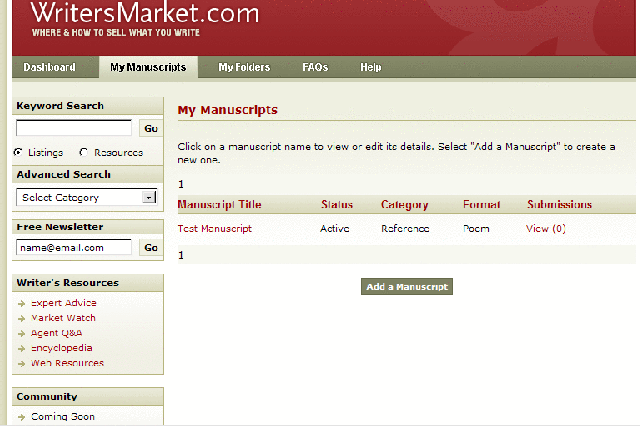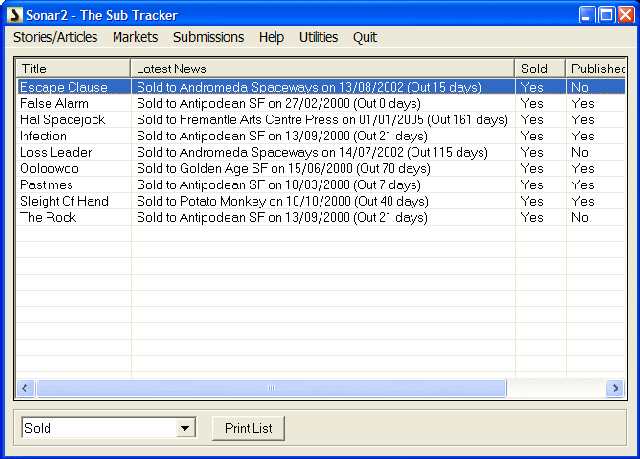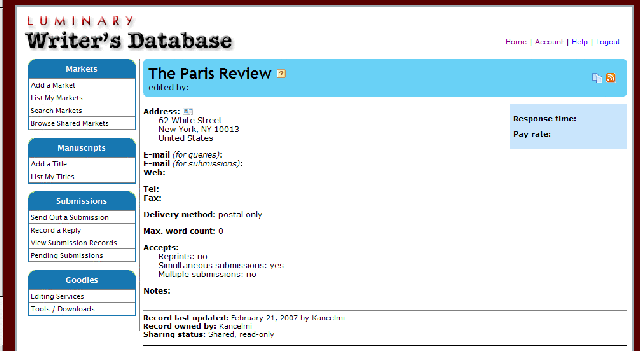Submission Tracking for Writers
One of the most important business skills a writer needs is the ability to manage the submission process. There’s a maxim out there, variously attributed, which says: “serious writers should keep their work in circulation until it either sells or the ink wears off”. It can be tricky to keep that circulation going, especially if you’re trying to get a variety of things published. There are some important things to remember and, below, I’ve listed a number of software options to help keep track of it all. To record all this information, there are many different manuscript tracking apps for writers to choose from, but none of them seemed to be just right. So, I built my own database. I call it “bestrew.” (It’s an unusual word that means “to scatter around.”) I built it for myself to use and for me it works pretty well, but there is definitely room to grow. I’m sharing it in the hopes of attracting a community around the idea. Perhaps we can devise an open source application to help writers track stay organized? Download from GitHub
What to track?
Here’s a thorough overview of the information you might want to record about your submissions . In summary, you want to track three things, along with several details about them:
- What have you created? (“works”)
- Where have you sent your work or where might you send it? (“venues”)
- Which works have you sent to which venues and what happened? (“submissions”)
My list was originally inspired by a guide on the subject during a conversation on a forum about software for writers , and it has been refined over the years according to my own needs and experience. Your needs and experience may vary, so I would love to hear about that.
Manuscript Submission Tracking Applications
There are many different software applications designed for writers who want to track their submissions. I decided to build my own, but many of these might be useful to you.
Web Applications
The (Submission) Grinder is a web-based submission tracker that aims to take over for Duotrope, which now charges $50 per year for its service. The (Submission) Grinder even accepts an imported .csv file from Duotrope’s export function, to make the transition easier. The site is still very new, but it is promising and the site administrator is eager to hear from users. If you need to track a market that isn’t currently listed in the application, you can submit one to be added. Submittable deserves some mention here. This submission manager by is used by magazines, journals, book publishers, and agents to receive submissions, but as a contributor you can use it to monitor any submissions you’ve sent via the application, at any of the venues that use Submittable. I wouldn’t be surprised if, someday, they add a way to track other submissions with this. Until then, like Duotrope, it’s only useful if you happen to be submitting to a publication that’s already on their list.

Writer’s Market provides a secure online service for Submission Tracking . You can purchase this service by the month, to try it out. The Writer’s Market software is easy to use, and it is integrated with the Writer’s Market directory of publications, which is quite useful. On the other hand, you cannot store information about a publisher who is not listed in the directory. Writer’s Market intends to add this feature , someday. Meanwhile, you might run into some trouble if, like me, you publish in obscure or non-paying publications. One-year access to this service is free when you buy a copy of the Writer’s Market Book . With an annual subscription fee, you would think this service would offer at least as many features as its competitors, but it does two things well – it helps you track submissions to the publications listed in Writer’s Market . It also helps you keep a list of those publications for yourself. The Luminary Writer’s Database is a web-based service for submission and publication tracking. It is free to use, and you can share information about publishers, with listings and comments. This isn’t a very popular website, judging from the number of user-submitted publisher entries. A few “coming soon” announcements littered throughout the website indicate that good things might be in the works for The Writer’s Database, so you may want to keep an eye on this one. (The writer’s database gets honorable technical mention for the use of VCARDs and RSS feeds. Its free, too.) Literarium is a web application under development that looks promising.
I worry a little that the development time for Literarium may be too slow. My hope is that Duotrope’s move to a paid model might spur some more rapid development for these kinds of apps, and if that happens, the most rapid developers will win the race.
Duotope
is a wonderful way to discover new markets for your writing, with its huge and growing directory of publications, but it doesn’t let you track submissions to anything that isn’t already listed in its databse, which renders it useless for anybody working with obscure or very new markets. It’s free, but charges a fee to get some of the more detailed information about the markets listed in its very detailed library. Duotrope is no longer free
, much to the consternation of many. There is a growing number of
alternatives to Duotrope
, though.
QueryTracker.net
is specifically designed to track submissions to publishers and agents, and includes access to a contacts database. Subscription to the database appears to be a paid feature.
Critique Circle Submissions Tracker
offers a free web-based submissions tracking service. A log-in account is required. Apparently designed specifically for genre fiction writers and only contains two fields: “title” and “notes.” This is not more useful than a spreadsheet and therefore not worth the effort of creating a login.
Assignmint
is a silicon valley startup company in its early stages. Its proposed website would connect publishers and writers.
Windows Software
Sonar is a manuscript submission tracking program that does pretty much everything that the Writer’s Market web service does, for free.

Sonar isn’t integrated with a publisher’s database, so you’ll have to enter that information in yourself, but that won’t kill you. This is the software that I eventually chose for tracking manuscripts in Windows.

Writer’s Database for windows is one I just heard about but haven’t tried.
InkLink is quite old now and kinda pricey but for some time it was one of the more popular Windows programs for Submission Tracking. It’s easy to see why.

This thing is loaded with features. The interface was easy and simple, and so was the user’s manual. In addition to listing manuscripts and publishers, InkLink would help you catalog things like travel expenses, too. The “reminder” feature was good, letting you know that its time for a submission’s second inquiry, etc., but it wouldn’t send you an e-mail. (The idea of a mobile alert is too new for this thing). Inklink would also help you create a writer’s resume, using the data you had already entered. Inklink charged $90, which seems steep, at first, but it is a one-time fee, unlike Writers Market.
SubTract is free to use and keeps track of things you have written, as well as any submissions you have made to publishers, magazines etc.
Power Tracker is windows software that is now more than 10 years old but may be useful for users of older machines.
Mac Software
StoryTracker is manuscript tracking software for iphones and the like but, for my part, I don’t enjoy doing that much typing, copying and pasting from an iOS device. Luckily, there is a version of StoryTracker for the Mac (and one coming soon for PC). I have high hopes for StoryTracker. There’s a demo version that you can use to try it out. When used in tandem, these two applications should prove to be both powerful and portable. With these, a database of publications or contacts can be exported or shared, which could lead to some interesting, sharable collections of lists, or perhaps even some compatibility with the directory web apps mentioned above? “Published!” by Ritsah Software and is pretty good not as simple and pretty as Manuscript Tracker was, and definitely more expensive. Mariner Software makes some great apps for writers, and their Montage and StoryMill apps both have built-in submissions tracking, but that functionality is only available inside of programs that do a lot of other things. Whether you use Montage or Storymill, you probably already have a dedicated writing application, and you might prefer to do your submissions tracking elsewhere.